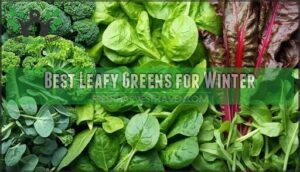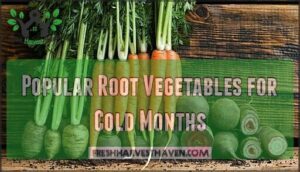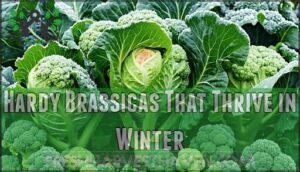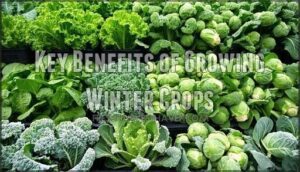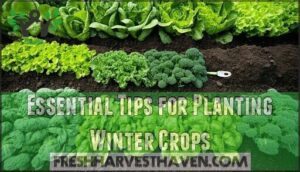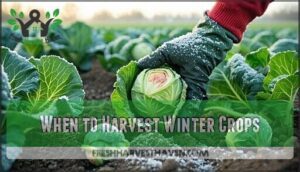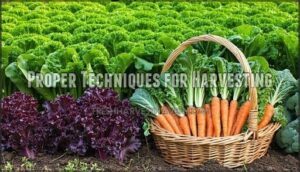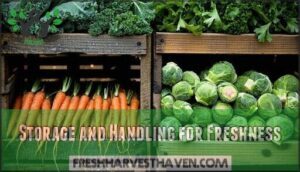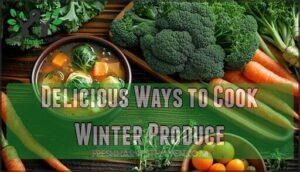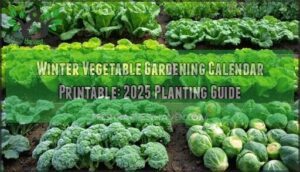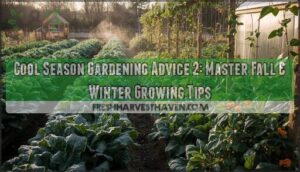This site is supported by our readers. We may earn a commission, at no cost to you, if you purchase through links.
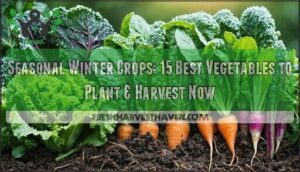
Leafy greens like arugula develop intense flavors in winter, while root vegetables like carrots become candy-sweet when stored in cold soil.
Winter crops cut your grocery bills and provide fresh nutrition when store produce is expensive. Plus, you’ll find that many vegetables prefer cool weather over summer heat, making winter gardening surprisingly productive and rewarding for your family’s table.
Table Of Contents
- Key Takeaways
- Top Winter Crops to Grow Now
- Key Benefits of Growing Winter Crops
- Essential Tips for Planting Winter Crops
- Harvesting and Storing Winter Vegetables
- Delicious Ways to Cook Winter Produce
- Frequently Asked Questions (FAQs)
- What crops can you grow in the winter?
- What vegetables are in season in winter?
- Which crop is best for winter?
- What is a cold season crop?
- Which crop grows in winter season?
- What are seasonal winter vegetables?
- What is the best crop for winter?
- What are 5 winter vegetables?
- How do winter crops impact soil health?
- What are common pests for winter vegetables?
- Conclusion
Key Takeaways
- You can grow hardy crops like spinach, kale, carrots, and broccoli in winter—they not only survive frost but actually get tastier and more nutritious.
- Winter vegetables, especially leafy greens and root crops, help cut grocery bills and keep your meals fresh when store produce is scarce or pricey.
- Planting at the right time and prepping soil for drainage are key to a productive winter garden; add mulch and use covers to protect crops from frost and snow.
- Winter crops improve your soil, curb erosion, and make organic growing easier by cutting down on pests and irrigation needs.
Top Winter Crops to Grow Now
You can grow plenty of nutritious vegetables throughout winter when you choose the right crops for cold weather. Hardy varieties like spinach, kale, carrots, and broccoli will produce fresh food even when temperatures drop below freezing.
Best Leafy Greens for Winter
Winter’s leafy superstars pack serious nutritional punch. Spinach is tricky to grow in warm weather but thrives in cold conditions, where frost sweetens its flavor profiles. Cold-hardy varieties in your Winter Salad Mix offer terrific pest resistance compared to seasonal produce from warmer months.
Your top seasonal food choices include:
- Kale varieties – Green curlies rank highest for winter hardiness and nutrient density
- Spinach cultivars – Cold-tolerant types handle frost better than seasonal items from summer
- Swiss chard – Rainbow varieties add color while delivering terrific gardening advice rewards
- Arugula – Peppery winter types develop intense flavors in cold weather
- Mâche (corn salad) – European favorite that’s virtually bulletproof in freezing temperatures
Popular Root Vegetables for Cold Months
Root vegetables are your garden’s treasure chest during cold months. Cold-Hardy Carrots become sweeter after frost, while Beetroot Cultivation thrives in cool weather. Radish Benefits include quick growth and vitamin C. For Turnip Growing Tips, harvest before heavy freezes.
These Winter Root Varieties store well in damp sand, providing seasonal produce throughout winter. Many gardeners find that including parsnips in recipes enhances their winter meals.
Hardy Brassicas That Thrive in Winter
Brassicas like kale, cabbage, and Brussels sprouts excel in cold weather thanks to their cold-hardiness mechanisms. These winter brassica varieties withstand seasonal factors that kill tender plants.
Their nutritional profiles peak during seasonal cycles, offering excellent pest resistance. Broccoli and cauliflower handle seasonal variation well, providing diverse culinary uses throughout seasonal change periods.
Key Benefits of Growing Winter Crops
You’ll boost your garden’s productivity and nutrition when you grow winter crops that thrive in cold weather. These hardy vegetables provide fresh produce year-round while improving your soil health and reducing grocery bills.
Nutritional Value of Winter Vegetables
Beyond basic nutrition, you’ll discover winter vegetables pack impressive nutritional density. Seasonal factors naturally concentrate nutrients in cold-hardy crops, creating powerhouse foods for your table.
- Vitamin Retention – Cold storage preserves vitamin C levels better than summer heat
- Mineral Content – Root vegetables absorb concentrated minerals from winter soil
- Antioxidant Power – Seasonal variation boosts protective compounds in leafy greens
- Fiber Benefits – Winter crops deliver higher fiber content with lower calorie density
Health Advantages of Winter Produce
Your winter harvest delivers powerful immune boosting compounds when you need them most. These nutrient density champions fight seasonal effects like winter blues and sluggish gut health.
Winter vegetables deliver powerful immune-boosting compounds that fight seasonal blues and support gut health when you need them most
Cold-weather crops offer better disease prevention benefits compared to summer varieties. That seasonal salad packed with kale and Brussels sprouts aids mental wellness during darker months.
Economic and Environmental Impacts
Your seasonal vegetable choices pack more than nutritional punch. Growing winter crops delivers significant economic output through year-round production and reduced seasonal fluctuation in farm income.
These hardy plants support soil health through natural crop rotation, preventing erosion while boosting carbon sequestration. Water conservation improves as winter vegetables need less irrigation. Organic production becomes easier with fewer pest pressures during cold months.
Winter weather impacts soil health directly, affecting productivity in the subsequent growing season.
Essential Tips for Planting Winter Crops
Winter crops need specific timing and soil conditions to thrive in cold weather. You’ll get the best results by planting at the right time, preparing your soil properly, and protecting your crops from harsh winter conditions.
Timing Your Winter Planting
Success hinges on understanding your first frost date and prime planting window. Regional climate variations create seasonal fluctuations that affect each crop’s timeline.
Check these key factors:
- Soil temperature needs – Most winter crops need 45-50°F soil
- Crop-specific calendars – Each vegetable has unique timing requirements
- Weather characteristics – Monitor seasonal rapid growth periods for particular season planting
Plan backwards from your target harvest date.
Soil Preparation for Cold Weather
Good timing sets you up, but proper soil prep makes winter crops thrive. Focus on drainage solutions first—waterlogged soil kills more plants than cold weather.
Add compost or aged manure for soil amendments that boost nutrient management. Apply mulch after planting to regulate seasonal fluctuations in soil temperature.
Test your soil’s cold hardiness by checking drainage patterns during this particular season.
Protecting Crops From Frost and Snow
Cold snaps don’t have to spell disaster for your winter garden. Use frost protection methods like breathable covers to keep plants 5°F warmer. Apply three inches of mulch for insulation against seasonal fluctuations.
Water crops before freeze events—moist soil holds heat better. Snow removal techniques matter too; gently brush heavy snow off delicate leaves to prevent breakage.
Harvesting and Storing Winter Vegetables
You’ll get the most from your winter harvest’s potential when you know the right time and technique for each vegetable.
Proper harvesting and storage methods keep your fresh winter crops nutritious and flavorful for months.
When to Harvest Winter Crops
Perfect timing determines your winter harvest success. You’ll know it’s time when maturity signs appear – firm heads on cabbage, tender leaves on kale. Weather impact affects best harvest time considerably. Check plants daily during the season since harvesting challenges increase with frost delays.
- Monitor leaf color changes and texture for readiness indicators
- Harvest before hard freezes damage crop quality
- Plan seasonal employment needs for peak harvest periods
Proper Techniques for Harvesting
During peak season, harvesting timing matters most for quality crops. Many seasonal workers learn that morning harvests yield better results when plants are fully hydrated.
Use sharp, clean tools to prevent damage and disease spread. Handle vegetables gently – bruised produce spoils faster. Cut leafy greens at soil level, twist root vegetables free carefully.
Quality assessment happens immediately after picking to make certain of peak freshness.
Storage and Handling for Freshness
Storage success hinges on post-harvest cooling and humidity control. Cool your winter crops to 32-38°F immediately after harvesting. Maintain 90-100% humidity to prevent wilting.
Handle vegetables gently, minimizing bruising that invites rot. Consider ethylene sensitivity when storing different crops together.
Storage duration varies by particular season conditions and seasonal variations in your harvest quality.
Delicious Ways to Cook Winter Produce
You’ve grown these hardy winter vegetables, and now it’s time to transform them into tasty meals that’ll warm your kitchen.
Winter produce like kale, carrots, and Brussels sprouts respond well to roasting, braising, and hearty soups that bring out their natural sweetness.
Easy Recipes for Winter Vegetables
After you’ve stored your winter harvest properly, you’ll want simple ways to enjoy these seasonal components. Quick Winter Soups transform root vegetables into hearty meals. Simple Roasted Veggies showcase natural flavors perfectly. Try Winter Salad Ideas using hardy greens for that cutting-edge salad appeal. One-Pan Winter Meals combine multiple vegetables effortlessly. Easy Winter Sides complement any dish beautifully.
Seasonal British cooking traditions offer time-tested recipes. These seasonal events in your kitchen create memorable family moments.
Best Cooking Methods for Cold-Season Crops
Roasting techniques bring out natural sweetness in winter vegetables.
Heat caramelizes their surfaces while keeping interiors tender. Even grilling winter produce** adds smoky depth to your modern salad creations.
Braising benefits dense roots like carrots and turnips, making them fork-tender. Soups & stews showcase seasonal British cooking traditions perfectly.
Try fermenting veggies for gut health.
Pairing Winter Veggies With Other Foods
Winter vegetables shine when paired thoughtfully. Roasted root vegetables complement proteins like beef or lamb perfectly. Brussels sprouts pair beautifully with bacon or pancetta.
Create modern salads by mixing kale with seasonal cheeses and nuts. Winter squash works well in seasonal activities like soup-making.
Try wine pairings with hearty stews featuring carrots and parsnips. These flavor combinations exceed seasonal norms for taste.
Frequently Asked Questions (FAQs)
What crops can you grow in the winter?
Like a garden’s quiet determination, you can grow spinach, kale, carrots, beets, broccoli, and cabbage through winter.
These hardy crops thrive in cold soil and actually taste sweeter after frost hits.
What vegetables are in season in winter?
You’ll find hearty vegetables like carrots, beets, and radishes thriving in cold soil. Spinach, kale, and cabbage handle frost beautifully, while Brussels sprouts actually taste sweeter after chilly nights.
Which crop is best for winter?
You’ll find spinach takes the crown here. The plant builds up sugars in response to cold, creating exceptionally sweet leaves. It’s tough, prolific, and thrives when others struggle.
What is a cold season crop?
Surprisingly, you’re already growing cold season crops if you plant broccoli, spinach, or peas in fall.
These hardy vegetables thrive in cooler temperatures below 70°F and can tolerate frost, unlike warm-season crops.
Which crop grows in winter season?
You can grow several hardy crops during winter months. Winter wheat, spinach, kale, carrots, and beets thrive in cold temperatures. These crops actually become sweeter after frost exposure.
What are seasonal winter vegetables?
Picture crunching on fresh carrots, pulling up sweet beets, or tossing kale in your soup pot. You can also plant spinach, turnips, cabbage, and broccoli—Mother Nature’s own way of tucking comfort into cold days.
What is the best crop for winter?
Spinach is your best bet for winter—it laughs in the face of frost. You’ll find it producing green leaves, even as the cold bites.
It keeps soil covered and gives you fresh, homegrown greens all winter.
What are 5 winter vegetables?
You’ll have good luck with cabbage, carrots, broccoli, kale, and radishes in winter.
These veggies don’t mind cold weather, and with a little mulch or row cover, they’ll keep your table well-stocked.
How do winter crops impact soil health?
Like a wool blanket for your fields, winter crops cover bare soil, lock in nutrients, and stop erosion. You’ll notice richer earth and fewer weeds when spring rolls around, making your next planting smoother and kinder to your ground.
What are common pests for winter vegetables?
You’ll battle aphids, cabbage worms, and cutworms as common pests. Keep an eye out for slugs, too. They love cool, damp weather.
Hand-picking, row covers, and regular checks help keep damage to a minimum.
Conclusion
Think of your winter garden as a savings account that pays you in fresh flavor and nutrition. By choosing the right seasonal winter crops, you’ll fill your table with greens and roots that thrive in the cold.
With a bit of science and timing, you can enjoy crunchy carrots, sweet kale, and sturdy brassicas well past frost. Use these tips to boost your harvest, stretch your budget, and keep meals exciting all winter long.
- https://www.johnnyseeds.com/growers-library/methods-tools-supplies/winter-growing-season-extension/winter-growing-guide-recommended-crops-varieties.html
- https://growinginthegarden.com/best-winter-crops-for-hot-summer-climates/
- https://www.forksoverknives.com/how-tos/winter-produce-guide-in-season-fruits-vegetables/
- https://portlandnursery.com/docs/veggies/FallWinterVegetables.pdf
- https://farmonaut.com/blogs/winter-wheat-production-7-key-sustainability-benefits

